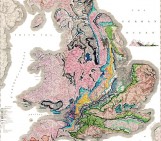Hi,
I’d like to begin by welcoming you to GeoSphere, a part of the new European Geosciences Union blog network (). I hope you enjoy your visit and learn something about the incredible and varied world of geology while you’re here.
The header image you see at the top of this blog is a photo that I took and I believe it shows the whole Geosphere. The geosphere is defined as anything in the solid earth. This includes all rocks, mineral and fossils. However, I like to think of the geosphere more holistically. In my mind the geosphere represents an integration of seemingly separate parts of the Earth. For example, the interaction between rocks, water and bacteria could be viewed was part of the geosphere, hydrosphere and biosphere. The separation of these interconnected aspects of environment does us all a disservice by making things that are integrally linked appear unrelated. In my eyes the geosphere can be redefined as the intersection between the lithosphere, hydrosphere, biosphere and atmosphere as these Earth systems are all connected and it is certainly more awe-inspiring but also better for scientific thought to recognize the interconnectedness of these aspects and unify them. I see this unification as the true definition of the geosphere. So back to the header image that I think represents the true geosphere. It includes rocks, water, ice, the atmosphere and some of the biosphere all in one beautiful place and marries them all to form a varied and unique environment.
The picture itself was taken by me while I was doing field work in the Yukon Territory. It is in Tombstone Territorial Park during the end of the spring melt season and the start of summer and the river is called the North Klondike River. As you can see there is still quite a bit of melting that has to occur.

A view of the GeoSphere as I see it. The photo is of the North Klondike River overlooking the Tombstone Mountains in the Yukon Territory, Canada. (Photo: Matt Herod)
Science outreach is something that I feel very strongly about. I truly believe that scientists have a responsibility to the the public, our sponsors, to communicate what we do and our findings openly and honestly. Not only that, scientists also have a responsibility to educate. In my experience the science of geology is very poorly taught in elementary and high school, at least, far worse than many other sciences. The aim of this blog is to engage in geology outreach and attempt to rectify this problem one post at a time. For the past two years I have been attempting to take things in the geosciences that interest me and write explanations for a lay audience in order to bridge the communication gap and make the fascinating world of geology accessible to anyone and I will continue to do so here.
I am in the lucky position of being a Ph.D student which affords me a terrific opportunity to see how research is done and interact with geologists from all over the world at conferences. I am also fortunate enough to have free access to many scientific articles through the university library and labs in the department, which gives me the opportunity to blog about new research. Indeed, stay tuned for some updates from our labs at uOttawa.
I am looking forward to getting some real content up here and I can’t wait to get going! Stay tuned and subscribe. Also, I am on Twitter @GeoHerod.
Cheers,
Matt

